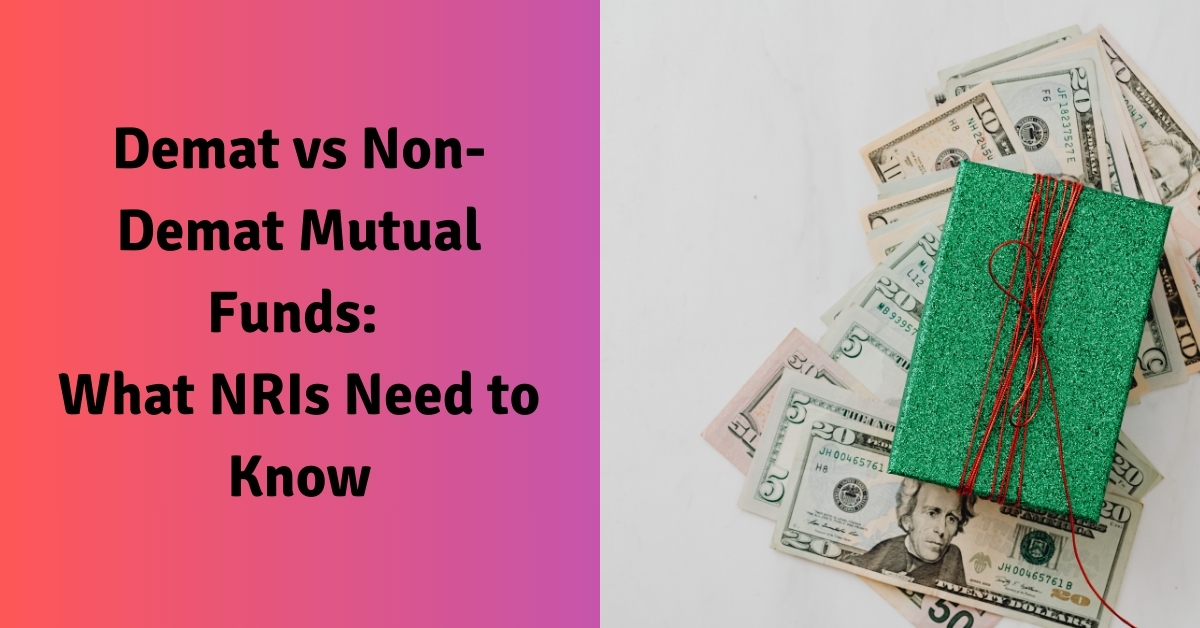Demat vs Non-Demat Mutual Funds: What NRIs Need to Know

For NRI investors in Indian mutual funds, one crucial decision often goes overlooked: whether to hold mutual fund units in Demat or non-Demat format. While both options are valid, the choice between them can significantly impact your investment flexibility and management capabilities. The non-Demat format, also known as Statement of Account (SoA) format, offers several advantages that deserve careful consideration.
The Limitations of Demat Holdings
Platform Dependency
One of the most significant drawbacks of holding mutual funds in Demat form is the restrictive nature of transactions. Investors are confined to their broker’s platform, losing access to alternative transaction channels like RTA portals, MF Central, and AMC websites. This limitation becomes particularly problematic during server downtimes or if you’re dissatisfied with your broker’s service quality.
Loan Against Portfolio Challenges
In today’s financial landscape, taking loans against mutual fund portfolios has become an attractive option, offering interest rates around 10% – significantly lower than personal loans or credit card debt. However, Demat holdings complicate this process. While securing such loans is straightforward with non-Demat holdings, Demat format requires obtaining a no-objection certificate from your broker. This requirement often leads to unwanted cross-selling of personal loan products by brokers.
Cost Implications
Demat accounts come with additional financial burden through annual maintenance charges. In contrast, non-Demat holdings allow investors to transact through multiple free platforms, including MF Utilities, MF Central, RTAs, and AMC websites, resulting in substantial cost savings over time.
Flexibility and Estate Planning
Transaction Limitations
Demat formats often restrict certain investment strategies, such as Systematic Transfer Plans (STP) and Systematic Withdrawal Plans (SWP), which many brokers don’t support. This limitation can hinder investors from implementing their preferred investment strategies effectively.
Estate Planning Considerations
Non-Demat holdings offer superior flexibility in estate planning. While Demat format enforces a uniform holding pattern and nominee structure across all schemes, non-Demat allows investors to maintain different holding patterns (single or joint) and nominee structures for different schemes. This flexibility is invaluable for comprehensive estate planning.
Making the Switch
Identifying Your Current Format
To determine whether your mutual fund holdings are in Demat or non-Demat format, simply visit MFCentral.com. The platform provides clear information about your holding format across different schemes.
Converting to Non-Demat Format
If you decide to switch to non-Demat format, the process involves submitting a rematerialization request form (RRF) to your broker. While the conversion process might take several weeks, it’s generally free, though some depositories might charge nominal handling fees.
Conclusion
For NRI investors, the non-Demat format offers superior flexibility, cost-effectiveness, and control over their mutual fund investments. While the Demat format might seem convenient initially, its limitations in terms of platform dependency, loan accessibility, and estate planning make the non-Demat format a more attractive option for most investors. Consider your investment goals, transaction needs, and long-term planning requirements when making this crucial decision.
FAQs
1. What is the main difference between Demat and non-Demat mutual fund holdings?
A: The main difference lies in how you can transact. Demat holdings can only be managed through your broker’s platform, while non-Demat holdings can be accessed through multiple platforms including RTA portals, MF Central, and AMC websites.
2. Are there any additional costs associated with Demat mutual fund holdings?
A: Yes, Demat accounts typically require annual maintenance charges, while non-Demat holdings can be managed through free platforms without additional costs.
3. Can I take a loan against my mutual fund holdings?
A: Yes, you can take loans against both formats, but non-Demat holdings make the process simpler and faster. Demat holdings require a no-objection certificate from your broker, which can complicate the process.
4. How can I check if my mutual fund holdings are in Demat or non-Demat format?
A: You can check your holding format by logging into [MFCentral.com](http://mfcentral.com/), which displays this information for all your schemes.
5. Can I have different nominee arrangements for different mutual fund schemes?
A: Yes, but only with non-Demat holdings. Demat format requires the same nominee structure across all schemes, while non-Demat allows different nominees for different schemes.
6. What is the process to convert Demat holdings to non-Demat format?
A: You need to submit a rematerialization request form (RRF) to your broker, who will forward it to the AMC/RTA for processing. The conversion typically takes a few weeks.
7. Are there any charges for converting from Demat to non-Demat format?
A: The conversion itself is generally free, though some depositories might charge a nominal handling fee.
8. Can I set up STP/SWP with Demat holdings?
A: This depends on your broker, as many brokers don’t support STP/SWP transactions in Demat format. Non-Demat holdings typically offer more flexibility with such features.
9. What happens if my broker’s platform is down and I need to make a transaction?
A: With Demat holdings, you’ll have to wait for the platform to be operational again. Non-Demat holdings provide multiple alternative platforms for transactions.
10.Can I have joint holdings in mutual funds?
A: Yes, but non-Demat format offers more flexibility. You can have different holding patterns (single/joint) for different schemes in non-Demat format, while Demat requires the same holding pattern across all schemes.




